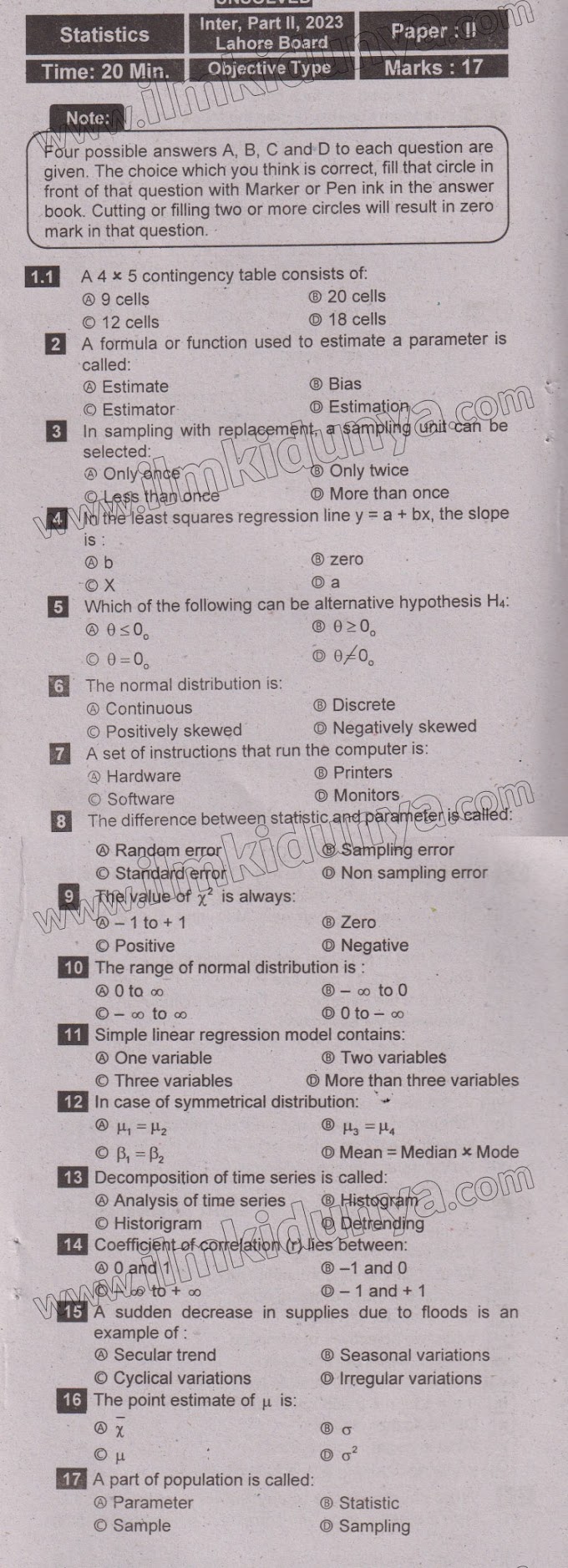Here you will see important short questions and important definitions of chapter 17 Orientation of Computer
Only request is to subscribe to this channel on youtube Welcome Academy for more videos about your paper.
12th class statistics chapter 17,Orientation of Computer,important definitions and short questions,2nd year class statistics
If you have any questions please leave a comment here,I will be very thankful to see your question.
#12thcalssstatistics #chapter17 #OrientationofComputer #shortquestions #definitionitons @12thcalssstatistics @chapter17 @OrientationofComputer @shortquestions @definitionitons #welcomeacademy123
Chapter 16: Orientation of Computer
These are very important question according to paper pattern.
Short Questions
Write short answers to the following questions.
Q.1 What is computer software?
ANS:
The set of instruction given to the computer to solve a problem or to control the operation of the computer is called software.
Q.2 What is binary number system?
ANS:
A number system in which there are only two digits “0” and “1” is known binary number system. In this system any number greater than “1” is represented by the combination of “0” and “1”.
Q.3 Why is binary system used in computer?
ANS:
Binary system has two digits 0 and 1. The 0 of binary system is linked with the state “off” and 1 is with the state “on” of electrical switch.
Q.4 Differentiate between hardware and software.
ANS:
Software: (1) Software is a set of instruction that tell a computer what to do. (2) Software cannot be touched.
Hardware: (1) Hardware is physical parts of computer that cause processing of data. (2) Hardware can be seen and touched.
Q.5 What do you know about DOS?
ANS:
DOS stands for disk operating system. The most widely used operating system on personal computers.
Q.6 What is RAM in the computer?
ANS:
RAM stands for random access memory. It is also called direct access memory. RAM is used to store data and instructions temporarily.
Q.7 What are the output devices in the computer?
ANS:
Output devices receive information from computer memory and transmit it into the outside world. Output devices are; Television Screen, monitors, Modem, printers etc.
Q.8 Enlist the main keys in a keyboard.
ANS:
Keyboard has 3 types of keys
(i) Alphabet Keys (ii) Numeric Keys (iii) Special Keys
Q.9 What is data processing?
ANS:
Data processing consists of series of operations performed on the data to achieve the required results.
Q.10 Differentiate between hard copy and soft copy.
ANS:
Hard Copy:(1) The copy which is printed in a paper or other element’s surface is called hard copy.(2) Hard copy is touchable. (3) Hard copy is the final stage of soft copy.
Soft Copy:(1)The copy which is stored in a memory and displays is a screen is called soft copy.(2) Soft copy is not touchable. (3) Soft copy is the primary stage of hard copy.
Q.11 What is meant by programming?
ANS:
Programming language is a means of communication between a user and computer. These languages are used to develop computer software.
Q.12 What are an Assembler and Compiler?
ANS:
A program which translates the source programs written in Assembly language into machine codes is called Assembler.
A program that translates that high level language into machine codes is called Compiler.
Q.13 What is keyboard?
ANS:
Keyboard is the most commonly used input device. Data is mostly entered by using a keyboard.
Q.14 How many are types of computer?
ANS:
Types of computers are: (i) Microcomputer (ii) Mainframe computer
(iii) Minicomputer (iv) Super computer
Q.15 What are output devices of computer?
ANS:
The devices that are used to return data to the user are called output devices. For example: monitor, printer etc.
Q.16 What is hybrid computer?
ANS:
A hybrid computer combines the best features of Analog and digital computers. It can work on binary system as well as physical values.
Q.17 What is CPU?
ANS:
The CPU is the brains of computer. It terms of computing power, the CPU is the most important element of a computer system.
Q.18 Differentiate between low level language and high level language.
ANS:
Low level language: The programming language that are close to machine codes are called low level language.
High level language: The programming languages that are close to human languages are called high level language.
Q.19 What is interpreter?
ANS:
The language processors that execute a source program by translating and executing one instruction at a time are called interpreters.
Q.20 What is secondary storage?
ANS:
The secondary storage is a device, which is used to store and retrieve data. It is a permanent storage but stored data can be erased.
Q.21 What is main memory or RAM?
ANS:
RAM stand for random excess memory. It is also called main memory. It is temporary storage of data.
Q.22 What is ROM?
ANS:
ROM stand for read only memory. The instructions into ROM chips are permanently written at the time of manufacturing. It is not possible to remove or write new instuctions.











2 Comments
gd
ReplyDeleteSir kindly definitions ko thora asan wordings may likh dein mera to exam ha kal but for upcoming students makes it easy , Thanks a Lot JazakAllah
ReplyDeleteThanks for message us We shall approve it if you have oxygen like words for us